
Guilford is an unincorporated community located in Howard County in the state of Maryland. The location is named after the Guilford Mill. Guilford is near Kings Contrivance, one of the nine "villages" of Columbia.
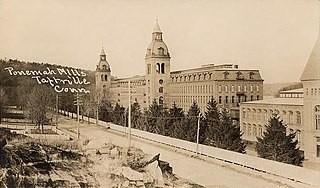
Taftville is a small village in eastern Connecticut. It is a neighborhood of Norwich but has its own post office. It was established in 1866 as site for the large Taftville Mill, later Ponemah Mill. The village is listed on the National Register of Historic Places as Taftville and as alternative name Taftville/Ponemah Mill National Register Historic District.

Shadwell is a census-designated place (CDP) in Albemarle County, Virginia. It is located by the Rivanna River near Charlottesville. The site today is marked by a Virginia Historical Marker to mark the birthplace of President Thomas Jefferson. It is listed on the National Register of Historic Places along with Clifton.
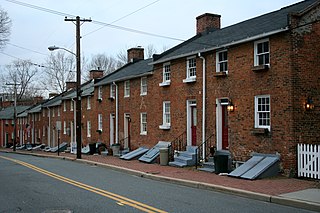
Oella is a mill town on the Patapsco River in western Baltimore County, Maryland, United States, located between Catonsville and Ellicott City. It is a 19th-century village of millworkers' homes.
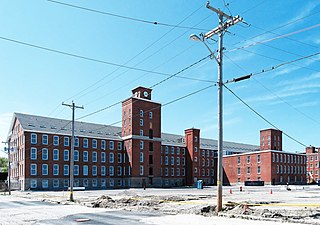
Wamsutta Mills is a former textile manufacturing company and current brand for bedding and other household products. Founded by Thomas Bennett, Jr. on the banks of the Acushnet River in New Bedford, Massachusetts in 1846 and opened in 1848, Wamsutta Mills was named after Wamsutta, the son of a Native American chief who negotiated an early alliance with the English settlers of the Plymouth Colony. It was the first of many textile mills in New Bedford, and gradually led to cotton textile manufacturing overtaking whaling as the town's principal industry by the 1870s.

The Slater Mill is a historic water-powered textile mill complex on the banks of the Blackstone River in Pawtucket, Rhode Island, modeled after cotton spinning mills first established in England. It is the first water-powered cotton spinning mill in America to utilize the Arkwright system of cotton spinning as developed by Richard Arkwright.

The Boston Manufacturing Company was a business that operated one of the first factories in America. It was organized in 1813 by Francis Cabot Lowell, a wealthy Boston merchant, in partnership with a group of investors later known as The Boston Associates, for the manufacture of cotton textiles. It built the first integrated spinning and weaving factory in the world at Waltham, Massachusetts, using water power. They used plans for a power loom that he smuggled out of England as well as trade secrets from the earlier horse-powered Beverly Cotton Manufactory, of Beverly, Massachusetts, of 1788. This was the largest factory in the U.S., with a workforce of about 300. It was a very efficient, highly profitable mill that, with the aid of the Tariff of 1816, competed effectively with British textiles at a time when many smaller operations were being forced out of business. While the Rhode Island System that followed was famously employed by Samuel Slater, the Boston Associates improved upon it with the "Waltham System". The idea was successfully copied at Lowell, Massachusetts, and elsewhere in New England. Many rural towns now had their own textile mills.
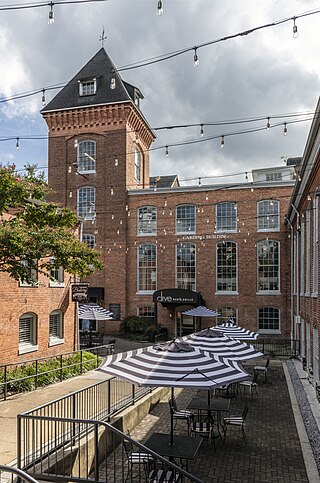
The Savage Mill is a historic cotton mill complex in Savage, Maryland, which has been turned into a complex of shops and restaurants. It was placed on the National Register of Historic Places in 1974. It is located in the Savage Mill Historic District. Buildings in the complex date from 1822 to 1916.

Harmony Mills, in Cohoes, New York, United States, is an industrial district that is bordered by the Mohawk River and the tracks of the former Troy and Schenectady Railroad. It was listed as Harmony Mills Historic District on the National Register of Historic Places in 1978. A portion of the district encompassing the industrial buildings and some of the housing built for millworkers was declared a National Historic Landmark in 1999. The centerpiece building, Harmony Mill No. 3 was listed on the National Register of Historic Places in 1971.
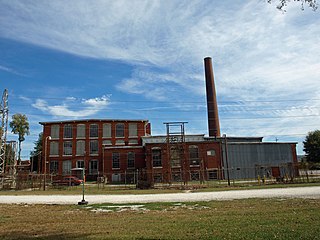
Lowe Mill is a former cotton mill of size approximately 171,000 sq ft (15,900 m2) located southwest of downtown Huntsville, Alabama.

The Whittenton Mills Complex is a historic textile mill site located on Whittenton Street in Taunton, Massachusetts, on the banks of the Mill River. The site has been used for industrial purposes since 1670, when James Leonard built an iron forge on the west bank of the river. The first textile mill was built in 1805 and expanded throughout the 19th century. The complex was added to the National Register of Historic Places in 1984, and now contains various small businesses.

Reef Bay Sugar Factory Historic District is a historic section of Saint John, United States Virgin Islands located on the south central coast adjacent to Reef Bay. The land is the site of a sugar factory. The property was added to the U.S. National Register of Historic Places on July 23, 1981.
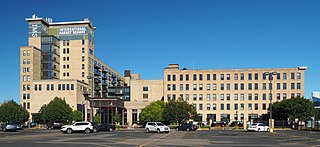
The Northwestern Knitting Company Factory, also known as Munsingwear Corporation and later as International Market Square, is a former factory building in the Sumner-Glenwood neighborhood of Minneapolis. The company was founded in 1888 by George D. Munsing, who invented a method of plating wool fibers with silk and cotton to make the union suit more comfortable. The company received financial backing from Clinton Morrison and Charles Alfred Pillsbury, who were prominent businessmen in the Minneapolis flour milling industry. This style of underwear, patented in 1891, proved to be very popular, and the company eventually became the world's largest manufacturer of underwear. The company changed its name in 1919 to Munsingwear.

Soulé Steam Feed Works is a historic business founded in Meridian, Mississippi in 1892 and incorporated in 1893 by George Soulé. The complex was listed as a contributing property to Union Station Historic District, which was placed on the National Register of Historic Places in 1979 under the Meridian Multiple Resource Area (MRA). It was listed as a Mississippi Landmark in 2003. The business, known for its many patented innovations in steam engine technology, reached its height around the turn of the 20th century, producing products that were sold around the world.

Roswell Mill refers to a cluster of mills located in Fulton County near Vickery Creek in Roswell, Georgia. The mills were best known for producing finished textiles from raw materials grown on nearby plantations, and the group was "the largest cotton mill in north Georgia" at its height.
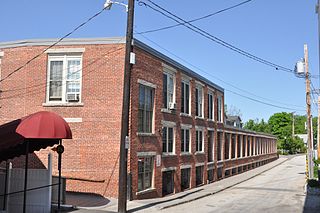
The Milford Cotton and Woolen Manufacturing Company is a historic mill complex at 2 Bridge Street in the center of Milford, New Hampshire. Developed between 1813 and World War I, it is one of the few surviving mill complexes in Milford, whose name is derived in part from "mill". The buildings were listed on the National Register of Historic Places in 1982. The complex has been converted into residential use.

The Cocheco Mills comprise a historic mill complex in the heart of Dover, New Hampshire. The mills occupy a bend in the Cochecho River that has been site of cotton textile manufacturing since at least 1823, when the Dover Manufacturing Company supplanted earlier sawmills and gristmills. The present mill buildings were built between the 1880s and the early 20th century, and were listed on the National Register of Historic Places in 2014.

The Boston Finishing Works is a historic industrial factory complex at 160 Water Street in Williamstown, Massachusetts. The site was developed industrially beginning in 1873, and was in regular use until 2000 as one of the town's major industrial employers. It was listed on the National Register of Historic Places in 2016.

Potrero Point is an area in San Francisco, California, east of San Francisco's Potrero Hill neighborhood. Potrero Point was an early San Francisco industrial area. The Point started as small natural land feature that extends into Mission Bay of San Francisco Bay. The Point was enlarged by blasted and cuts on the nearby cliffs. The cut material was removed and used to fill two square miles into the San Francisco bay, making hundreds of acres of flat land. The first factories opened at Potrero Point in the 1860s. Early factories were powder magazine plant, the Pacific Rolling Mill Company and small shipyards. The large Union Iron Works and its shipyards were built at the site, stated in 1849 by Peter Donahue. To power the factories and neighborhood coal and gas-powered electricity works were built, later the site became Pacific Gas and Electric Company (PG&E).























